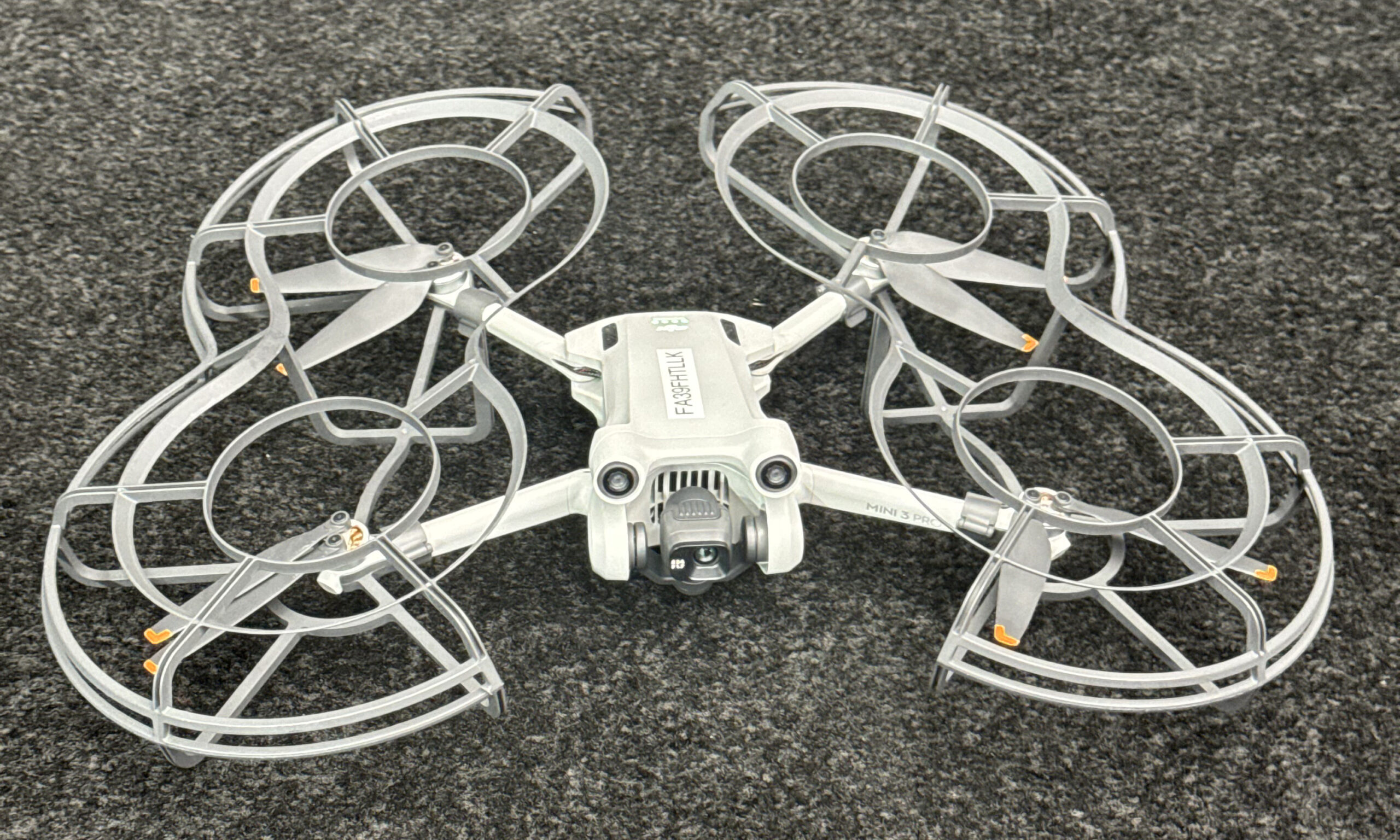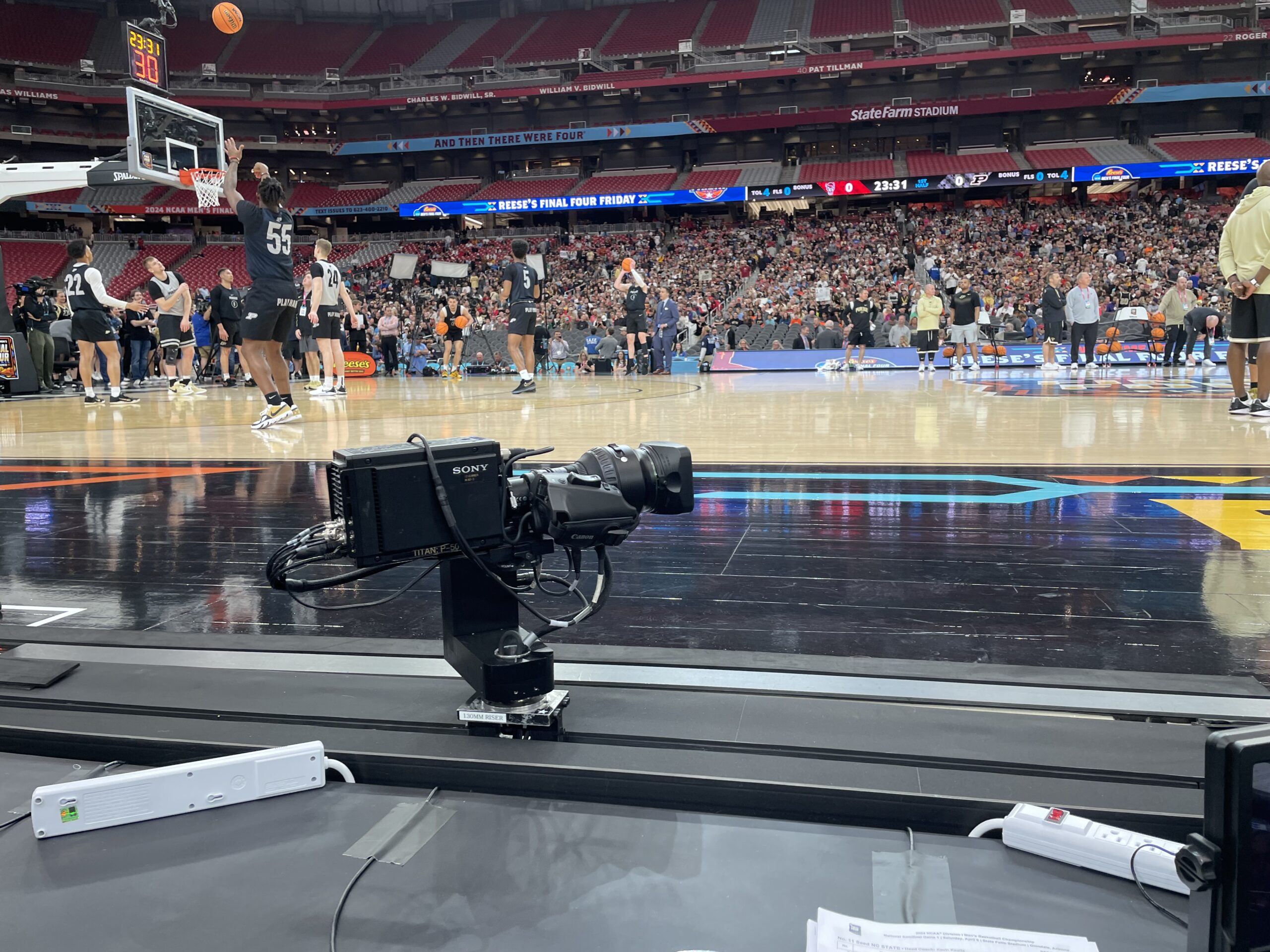Live From NCAA Men’s Final Four: TNT Sports, CBS Sports Capitalize on Greater Freedom to Fly Live Drone Inside, Bring Back SkyCam to Supplement Massive Production
Huge show features more than 75 cameras inside State Farm Stadium
Story Highlights
Aerial cameras have been all the rage in live sports production lately and at TNT Sports’ and CBS Sports’ massive production effort behind this weekend’s NCAA Men’s Basketball Final Four at State Farm Stadium in Glendale, AZ, that trend holds true.
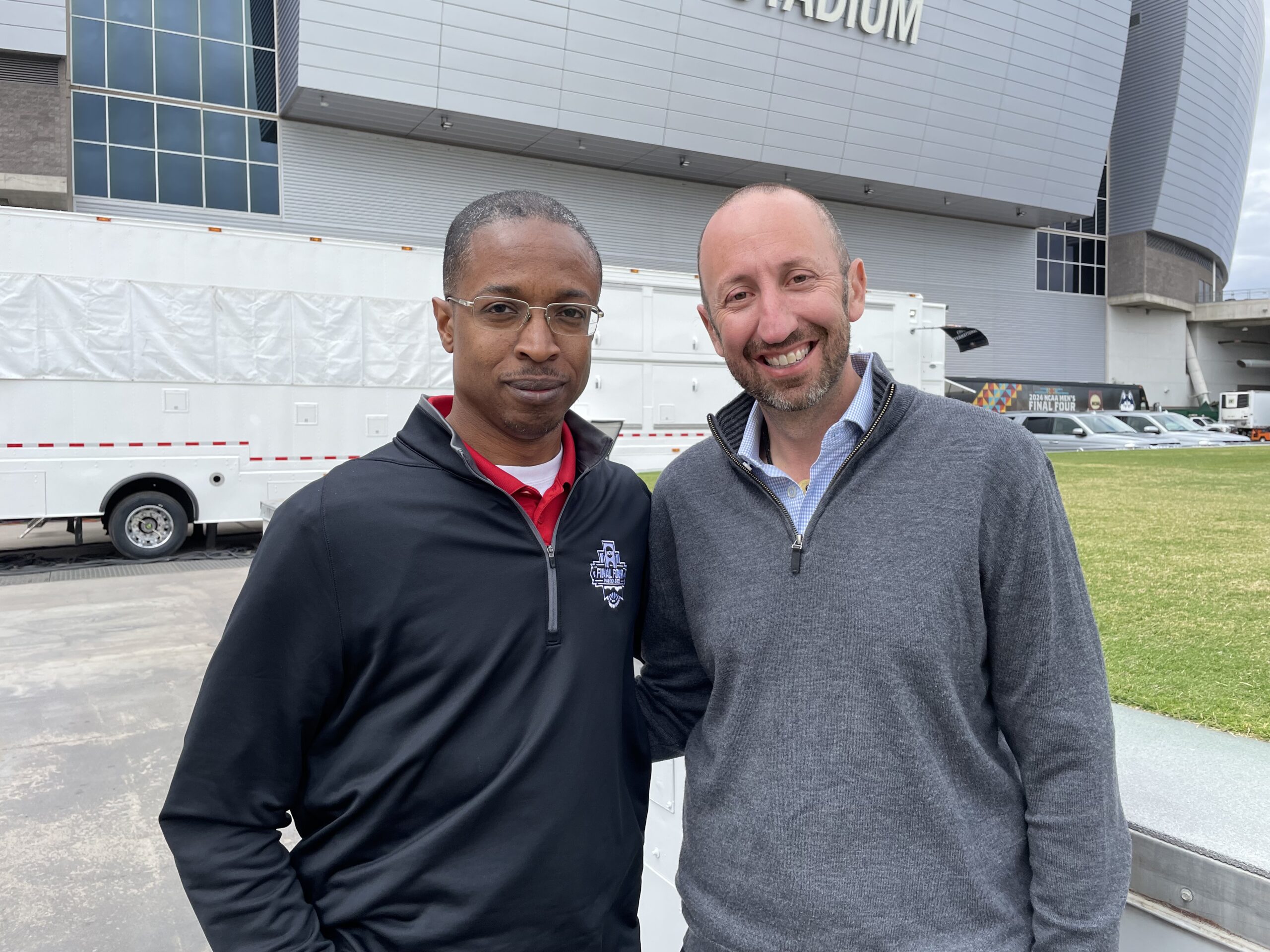
Chris Brown, VP, Technology and Operations at TNT Sports and Jason Cohen, SVP, Remote Technical Operations at CBS Sports again helped lead a collaborative operations effort between their two networks at the NCAA Men’s Basketball Final Four.
After first introducing limited use of a live drove inside the stadium bowl at last year’s Final Four, the broadcasters have been granted greater freedom to fly and take live shots from inside the stadium during game action.
“I think there’s a great opportunity to showcase the drone and show the value that it can bring to the production,” says Chris Brown, VP, Technology and Operations at TNT Sports. “I think we’ve made some good [progress] with the NCAA and with [State Farm Stadium] so we are definitely looking to lean more heavily into it, both on the studio and the game side. I think it’s going to create some unique looks and a different way to present the game.”
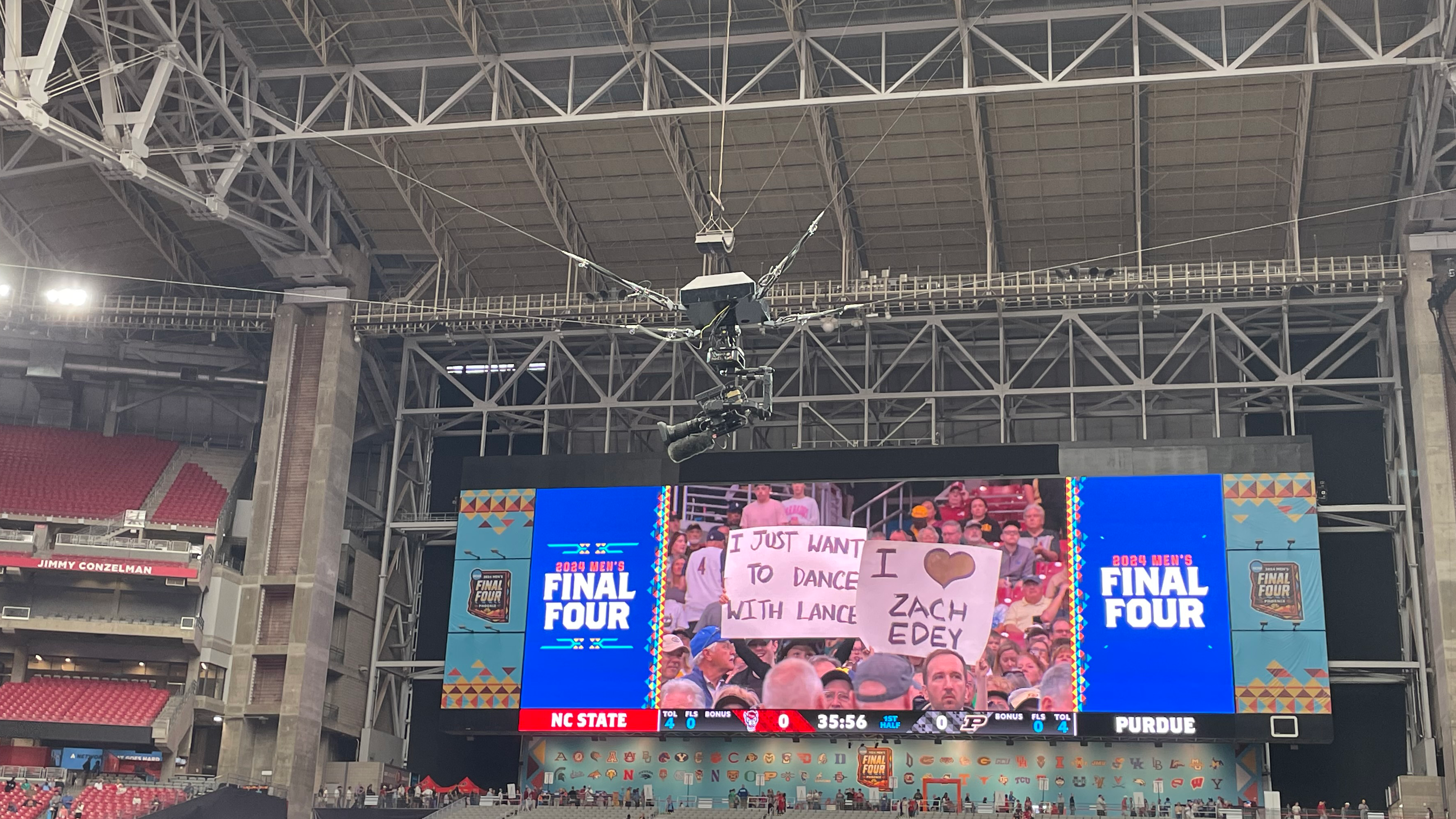
SkyCam returns to coverage of the NCAA Men’s Basketball Final Four. It wasn’t used last year when the centerhung videoboard at NRG Stadium in Houston sat too low for the four-point system to be rigged safely.
On top of the drone, SkyCam also returns to the camera lineup. The system is commonly used by CBS Sports and TNT Sports at this event but it was absent last year in Houston due to a low-hanging centerhung videoboard at NRG Stadium.
“Every year we at CBS and our friends at TNT Sports sit down and take a look at what added value the previous year and what we want to bring back or modify,” says Jason Cohen, SVP, Remote Technical Operations at CBS Sports.
One example of a modification this year comes on the popular RailCam. Last year, the broadcasters introduced a double RailCam with two camera heads running along the same rig. After weighing their options, TNT and CBS have reverted back to a single camera on the RailCam.
Live Drones: Continuing to Build the Case
The live drone being used here at the Men’s Final Four comes from the Warner Bros. Discovery family. CNN AIR, the news network’s internal drone division; a deployment at this event that first began last year.
In Houston, TNT Sports and CBS Sports were able to fly a drone inside the domed NRG Stadium, marking a first for the NCAA Tournament. However, the drone was limited to a very limited flight path that allowed it to basically rise and fall in a single vertical path in one corner of the bowl.
Now, the broadcasters have been granted permission by the NCAA and State Farm Stadium to fly much more freely throughout the stadium. The drone still cannot fly directly over court but the images the drone can deliver should be dramatically more dynamic than a year ago.
“Drone integration in sports is a marathon, not a sprint,” says Cohen. “I think we’re all trying to get to the same place, which is the holy grail of drone use being used as a live game coverage camera to get you to places that you can’t ordinarily get to with your normal cameras. But you have to go about it smartly and safely and methodically.”
Cohen and Brown called it “a giant step forward” and described that the hope was to fly the drone from outside to inside the building and even follow players onto the court. It’s going to come in and out of the building, it’s going to follow players onto the court, a giant step forward from where we were last year. And I think that’s just the goal is to keep on,
“The march forward is about comfortability,” adds Brown. “Not only are you trying to march forward safely, but in a way that makes all of the interested parties very comfortable and that we’re stepping together. I feel like that’s what we’ve done. Working that cadence between SkyCam flying on its four-point system and the drone with its flight paths is also crucial; making sure that the two shall never meet is probably the number one most important aspect of trying to figure all this out.”
Camera Lineup Continues to Grow
The aerials are just a piece of a camera arsenal that pushes north of 75 inside State Farm Stadium.
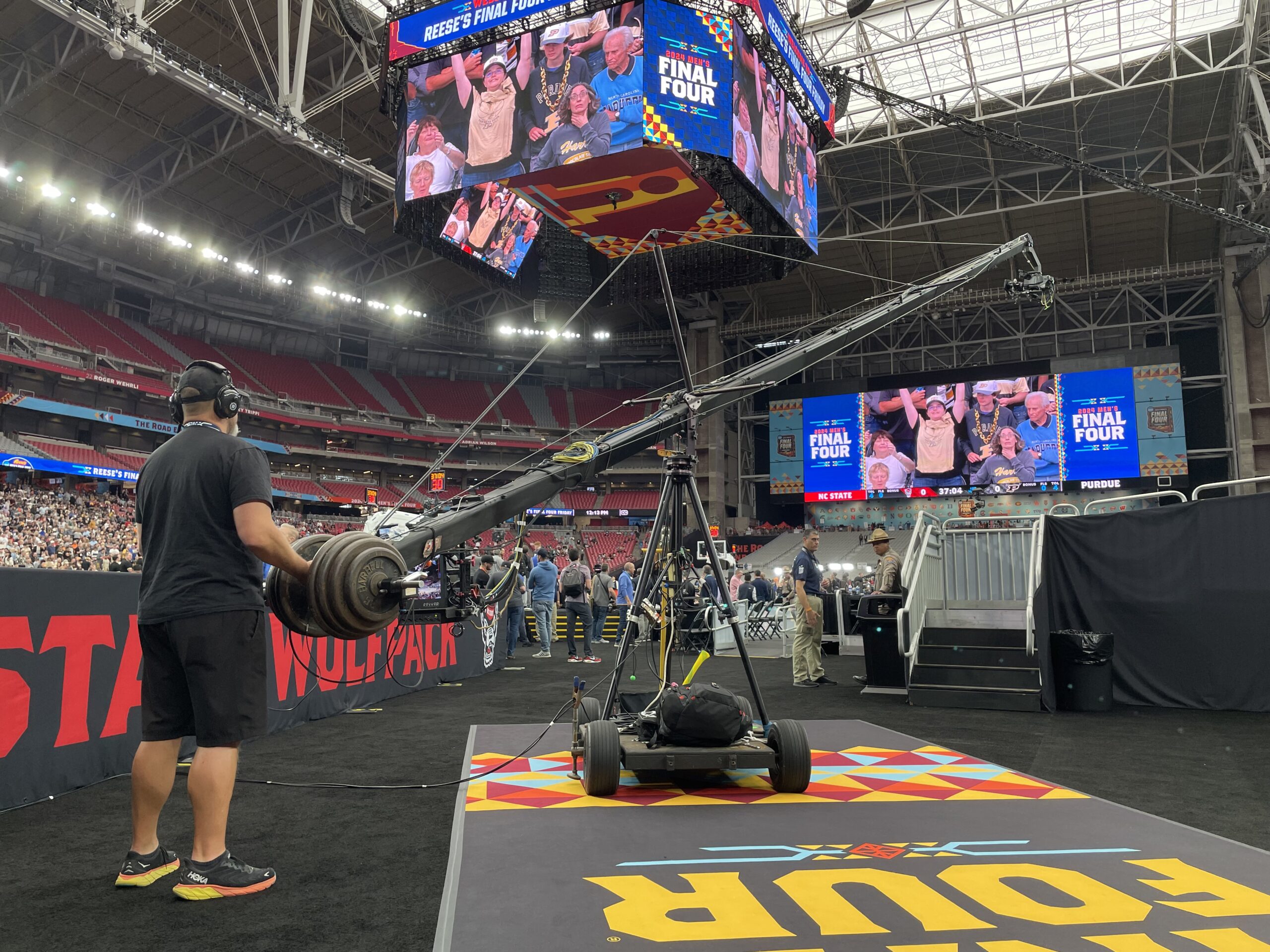
TNT Sports and CBS Sports have brought three jibs to its coverage of the NCAA Men’s Basketball Final Four.
There’s the aforementioned RailCam, as well as 17 super slow-mos, three large jibs, an on-court RF shooting in shallow depth of field, slow-mo robos above the backboards and 4K-capable, 4X robos above the rims, additional cameras shooting in 6X and slash cameras in two of the four corners of the court.
Game Creek Video’s Encore multi-truck production facilities anchor the live game coverage. NEP Group’s ST27 is making its debut at this event and handling transmission.
Talented Crews Grind Out a Busy Stretch
Not to be lost on the tremendous effort being done here in Glendale is the fact that both TNT Sports and CBS Sports are in the midst of quite busy stretches for their respective companies.
TNT Sports just began its MLB season and is continuing its NBA and NHL schedules all while renovations continue to occur at its Atlanta headquarters. This was a Super Bowl year for CBS Sports and The Masters begins Thursday.
On the TNT Sports front, the huge live production is supported by Senior Director of Tech/Remote Operations and Crewing Vanessa Lindsey; Senior Director Strategic Production Planning Lee Estroff; Manager, Strategic Production Planning James Bligh; Senior Director Remote Engineering & Operations Dan Nabors; Associate Tech Operations Manager Travis Cabellero; Tech Operations Manager Brent Brown; Production Manager Luca Baglioni; Production Coordinator Claire Carpenter; Senior Director, Production Management Sarah Philips; Remote Studio Tech Managers Jordan Keen and Chris Monroe; and Twitter Live Tech Manager Jon Hazell.
The CBS team features EVP, Operations and Engineering Patty Power; VP, Engineering and Technology Mike Francis; VP, Production Management Krissi Florian; VP, Broadcast Operations Scott Davis; VP, Post Production & Media Operations Ed Coleman; VP, Sports IT and Engineering Bernie Courtney; Senior Director, Venue Engineering and Planning Evelyn Jackson; Remote Engineering and Planning Jeff Millet; Coordinator, Remote Engineering Meredith Kolodney; Senior Director, Remote Production Management Jeff Korotkin; Director, Broadcast Production/Operations George Dimotheris; Senior Director, Broadcast Operations + Solutions Alyssa Blake; Director, Remote Technical Operations Jenna McKeon; Field Tech Managers DJ Driscoll, Brian Irizarry, Michael Aagaard, and Kachi Del Valle; Manager, Labor Coordination Sue Brown; Production Manager, Unit Manager Jill Calandra; Director, Remote Operations Marc Magnotta; Operations Production Manager Chad Granieri; Production Manager, Remote Operations Emily Sandor; Production Managers Greg Frias, Marie Jones, Taj Lewis, Lori Migliaro, and Leiza Palpant; Operations Coordinators Meaghan McConnell and John Dorado; Production Coordinator Phil DeMaddalena; and Crewing Coordinator Lindsey Yeager.
